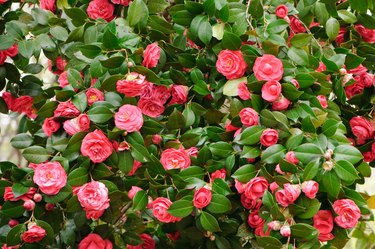
Many gardeners consider camellias (Camellia spp.) as 10- to 12-foot shrubs, but their size can be misleading. These slow-growing, broadleaf evergreens often outlive their gardeners, so mature size remains a mystery to some. With varieties hardy in U.S. Department of Agriculture plant hardiness zones 6 through 10, mature camellias can reach 25 feet or more in height -- but they may take a century to reach it. With growth that slow, simple pruning easily keeps camellias in form.
General Pruning
Video of the Day
Established camellias need only minimal pruning. If desired, shape and thin camellias immediately after blooming ends, right as new spring growth begins. Waiting until later in the growing season sacrifices the flower buds that deliver camellias' winter blooms. When pruning to limit size, remove interior branches first, then finish with general shaping. Cut crossing or crowded branches back to a primary branch or an outward-facing bud. This points new growth in the right direction and reduces future pruning needs. Use the plant's natural shape as guide, and remove unwanted, wayward shoots. Prune out dead, damaged or diseased branches any time of year.
Video of the Day
Major Rejuvenation
If overgrown camellias lose their vigor, severe pruning can help restore them. Do this as blooms wind down in late winter, after Valentine's Day has passed. Plan major rejuvenation over a three-year period, and remove one-third of the plant each year. Start by removing old, unproductive stems in the shrub's interior to open the plant to light. Remove branches all the way back to the main stem or a large, vigorous shoot. Work evenly throughout the shrub, and cut back the remaining two-thirds as needed for shape. When cut back severely, camellias usually do not bloom the following winter. Flower buds should set and progress normally the next year.
Tools for the Task
Proper pruning tools yield better results for you and your camellias. Sharp, handheld, bypass pruners handle stems 1/2 inch in diameter or smaller. Bypass pruners leave clean, concise, quick-healing cuts. For branches up to 1 inch in diameter, use long-handled bypass loppers. These provide extra leverage so stems aren't crushed or ripped. For 1-inch-diameter and larger branches, use a curved pruning saw. Wear protective clothing, including gloves and safety glasses, and sterilize pruning blades with household disinfectant before and after pruning each bush. If insects or disease are present or suspected, sterilize blades before and after each cut. Pruning seals should not be used.
Bloom Removal
As camellia blossoms come and go, spent blooms can detract from a shrub's beauty. Wilted blossoms may hang on for weeks, and fallen blooms can host disease. Some gardeners turn to pruners, but a hands-on approach works best. Camellia blossoms appear in clusters; pruners risk damage to nearby buds. In addition, the stem's growing tip lies just below camellia blooms. To protect the growth bud and flowers in waiting, deadhead camellias by hand and not by shears. Hold the stem below the wilted flower as you firmly, yet gently, pull and twist the spent bloom. Always keep the ground free of bloom debris.